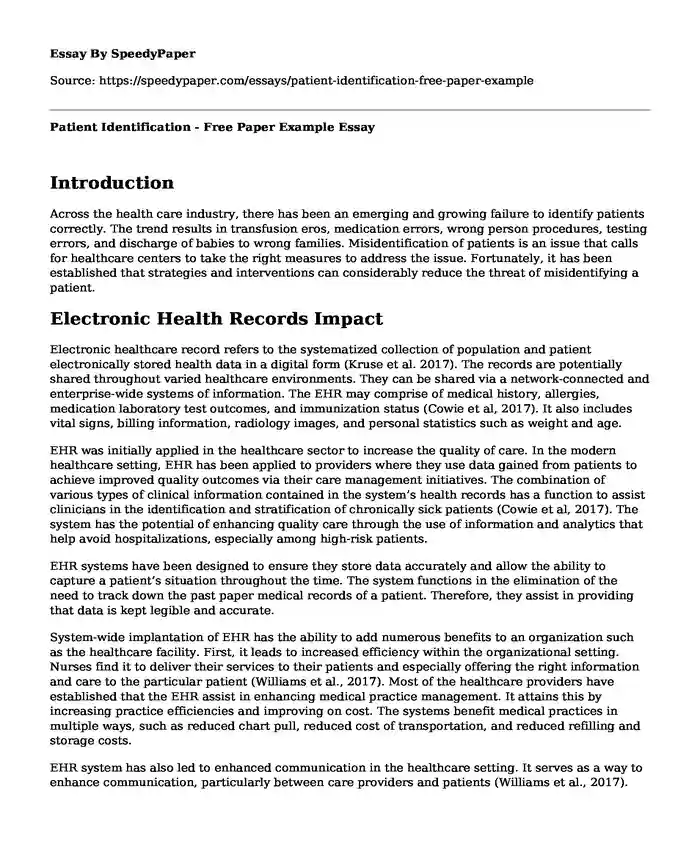
| Type of paper: | Essay |
| Categories: | Nursing Electronics Healthcare |
| Pages: | 3 |
| Wordcount: | 683 words |
Introduction
Across the health care industry, there has been an emerging and growing failure to identify patients correctly. The trend results in transfusion eros, medication errors, wrong person procedures, testing errors, and discharge of babies to wrong families. Misidentification of patients is an issue that calls for healthcare centers to take the right measures to address the issue. Fortunately, it has been established that strategies and interventions can considerably reduce the threat of misidentifying a patient.
Electronic Health Records Impact
Electronic healthcare record refers to the systematized collection of population and patient electronically stored health data in a digital form (Kruse et al. 2017). The records are potentially shared throughout varied healthcare environments. They can be shared via a network-connected and enterprise-wide systems of information. The EHR may comprise of medical history, allergies, medication laboratory test outcomes, and immunization status (Cowie et al, 2017). It also includes vital signs, billing information, radiology images, and personal statistics such as weight and age.
EHR was initially applied in the healthcare sector to increase the quality of care. In the modern healthcare setting, EHR has been applied to providers where they use data gained from patients to achieve improved quality outcomes via their care management initiatives. The combination of various types of clinical information contained in the system’s health records has a function to assist clinicians in the identification and stratification of chronically sick patients (Cowie et al, 2017). The system has the potential of enhancing quality care through the use of information and analytics that help avoid hospitalizations, especially among high-risk patients.
EHR systems have been designed to ensure they store data accurately and allow the ability to capture a patient’s situation throughout the time. The system functions in the elimination of the need to track down the past paper medical records of a patient. Therefore, they assist in providing that data is kept legible and accurate.
System-wide implantation of EHR has the ability to add numerous benefits to an organization such as the healthcare facility. First, it leads to increased efficiency within the organizational setting. Nurses find it to deliver their services to their patients and especially offering the right information and care to the particular patient (Williams et al., 2017). Most of the healthcare providers have established that the EHR assist in enhancing medical practice management. It attains this by increasing practice efficiencies and improving on cost. The systems benefit medical practices in multiple ways, such as reduced chart pull, reduced cost of transportation, and reduced refilling and storage costs.
EHR system has also led to enhanced communication in the healthcare setting. It serves as a way to enhance communication, particularly between care providers and patients (Williams et al., 2017). The communication can only be improved if the system is applied in the right way. Full integration of the EHR system into the visit and perceived as an additional tool used in the treatment process, patients are less likely to perceive it as a source of distraction. Besides, the system has helped result in improved practitioner performance and outcomes.
Conclusion
Despite the significant benefits of the EHR system, the design, customization, and application of the system by nurses, doctors, and other clinicians potentially result in inefficiencies or challenges in work flow. To overcome the challenges, the federal government must ensure it provides certification principles for the system. Technology developers ought to state that their engagement includes end-users and conduct testing of usability when designing and developing the system.
References
Cowie, M. R., Blomster, J. I., Curtis, L. H., Duclaux, S., Ford, I., Fritz, F., ... & Michel, A. (2017). Electronic health records to facilitate clinical research. Clinical Research in Cardiology, 106(1), 1-9. DOI 10.1007/s00392-016-1025-6
Kruse, C. S., Smith, B., Vanderlinden, H., & Nealand, A. (2017). Security techniques for the electronic health records. Journal of medical systems, 41(8), 127. DOI: 10.1007/s10916-017-0778-4
Williams, K. S., Shah, G. H., Leider, J. P., & Gupta, A. (2017). Overcoming barriers to experience benefits: a qualitative analysis of electronic health records and health information exchange implementation in local health departments. eGEMs, 5(1). DOI: 10.5334/egems.216.
Cite this page
Patient Identification - Free Paper Example. (2023, Dec 12). Retrieved from https://speedypaper.com/essays/patient-identification-free-paper-example
Request Removal
If you are the original author of this essay and no longer wish to have it published on the SpeedyPaper website, please click below to request its removal:
- Skills for Disruptive Digital Business - Free Essay with the Article Review
- Interpretability in Machine Learning: A Requirement for Trustworthiness - Essay Sample
- Affordable Medical Record Software: Improving Patient Care with Education - Essay Sample
- Information Security in a World of Technology - Essay Sample
- Planning and Measurement in Halthcare Organizations - Essay Sample
- Free Paper Sample on Nursing Informatics
- Government Intervention in Unhealthy Eating: A Path to Public Health Improvement and Reduced Healthcare Costs
Popular categories




